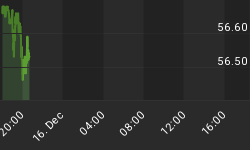This indicator can tell you "when not to trust the Relative Strength Indicator" ...
There is a time to not trust what the Relative Strength indicator is telling you. But how do you know it is a "don't trust the Indicator day"?
Today's chart gives you the answer. In today's chart, we show a 9 and 30 day Relative Strength, plotted against INVERTED Declining Volume action, and against the action of the NYA Index.
Two important notes before we continue further ...
- Our Relative Strength indicator is called the C-RSI. (Don't let that confuse you ... C stands for Chenard, and the RSI is the normal acronym for Relative Strength Index.)
- The only way our C-RSI is different, is that we take the same RSI readings and subtract a value of 50 from it. Since 50 is neutral on the standard RSI indicator, it becomes 0 for neutral on our indicator. That makes any positive or negative levels stand out as being above or below the zero line. A much easier way to interpret the RSI reading.
- Normally, the Declining volume tracks inversely with the market, so we inverted it so that it tracks in the same direction the market is going.
With that said, let's look at today's chart to see why you can't always trust the Relative Strength Indicator by itself. By the way, this chart was created at approximately 9:40 AM this morning.
Okay ... look at the "whole chart" and note that every time the 9 day C-RSI went down or up, the Inverted Declining Volume went down or up at the same time. AND, the NYA Index went in the SAME direction at the same time. EXCEPT FOR THIS MORNING.
The 9 day C-RSI went down this morning, but the Inverted Declining Volume went in the opposite direction.
This morning was the first time since the end of June that the two indicators did NOT track in the same direction together ... and that meant that you shouldn't trust what the RSI was telling you at the open this morning.
(FYI reference for our paid subscribers: This (daily updated) chart is part of the larger chart found on the Standard site; Section 2, the fourth chart down from the top. It is part of the Multi-Indicator Model chart.)

















